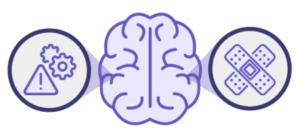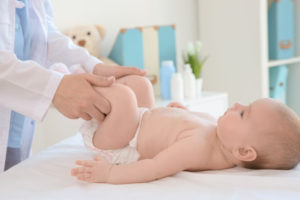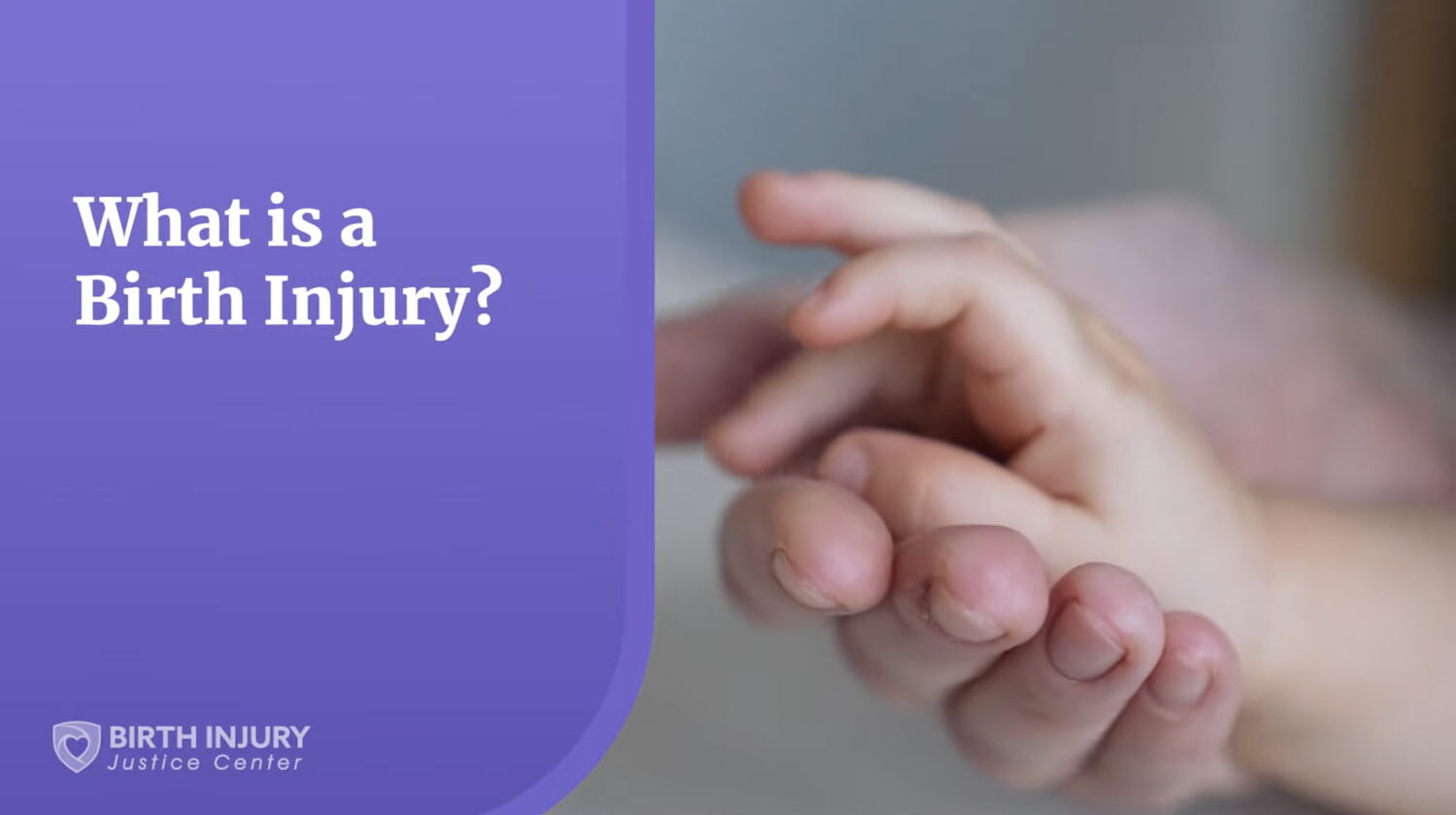What Is a Birth Injury?
Birth injuries (also called birth trauma) describe any type of physical harm to a newborn baby before, during, or shortly after delivery.
Watch our short video to better understand birth injuries in newborns and what to do if your child was harmed.
Birth injuries are caused by physical harm during childbirth. If your child’s injury was avoidable, you may be able to get financial aid for care. Call (800) 860-6795 for legal assistance.
Duration: 1 min 11 sec
Many babies suffer minor injuries during the delivery process that heal by themselves or can be managed with prompt and proper care. Unfortunately, severe birth injuries often have no cure, and your child may have a physical or intellectual disability for the rest of their life.
Some birth injuries of newborns are unavoidable, but others could have been prevented with proper medical care.
Alarmingly, medical professionals are known to downplay their role in birth injuries. Some even try sweeping mistakes under the rug or offering a quick lowball settlement to make the matter “go away.”
For this reason, it is essential for families who suspect something may have gone wrong during childbirth to trust their instincts. Seeking help from an experienced birth injury lawyer is often the best way to protect your child’s future.
If you believe your child suffered a birth injury due to medical malpractice, you may be eligible for financial compensation to help pay for your child’s treatment.
Get a free case review now.
Birth Defects vs. Birth Injuries


Birth defects and birth injuries are not the same. The most notable difference between birth injuries and birth defects is how they develop.
Birth Defect
A birth defect usually forms while a baby is still in the womb. According to the Centers for Disease Control and Prevention (CDC), birth defects typically develop within the first three months of pregnancy. Factors like family medical history, maternal health conditions, smoking, alcohol, or drug use may increase the risk of birth defects.
Birth Injury
To define birth injuries, it’s important to understand they are conditions that generally develop before, during, or immediately after a baby is born. For example, if a baby suffers physical trauma to the head due to too much force during delivery, they may be born with a birth injury.
Causes of Birth Injuries
Birth injuries can be caused by factors such as fetal health issues, maternal health issues, or external conditions like medical malpractice or medical negligence.
Fetal Risk Factors
- Breech (buttocks or feet first) delivery
- Decreased blood flow (ischemia)
- Fetal infection
- Oxygen deprivation (hypoxia)
Maternal Risk Factors
- Diabetes
- Maternal infection
- Obesity
- Shape of the mother’s pelvis
Medical Negligence
Sometimes, birth injuries are caused by medical negligence on behalf of health care professionals. Doctors, nurses, midwives, and other medical professionals can be negligent with their care, which can injure delicate newborns.
Birth Injuries and Medical Malpractice
Delivery teams are trained to respond to any emergency that could arise during childbirth. They must be able to make lightning-fast decisions and manage any risks to the mother or child.
However, some medical professionals do not uphold the standard of care and cause preventable harm.
Nurses trained in the Neonatal Resuscitation Program (NRP) are equipped with the latest knowledge and skills to respond quickly and effectively in emergencies. They use their understanding of the baby’s health, the mother’s medical history, and risk factors to make fast, life-saving decisions at a time when every second counts.
Here are some examples of situations that could be considered birth injury medical malpractice.
C-Section Complications
C-section injuries happen when a doctor performs an unsafe cesarean section, leading to complications that may affect both the mother and baby.
In other cases, a doctor may fail to perform an emergency C-section when it would have been the safer way to deliver a baby.
Forceps Delivery Complications
Forceps are an assistive delivery tool that looks like large tongs. They are sometimes used in vaginal deliveries, especially when labor stalls in the second stage.
While most deliveries involving the use of forceps are successful, improper use can cause harm to the baby. When forceps delivery complications arise, they can lead to severe birth injuries, such as bleeding in the baby’s skull and seizures.
Vacuum Extraction Complications
Some doctors may use vacuum extractors to help pull out a child that is stuck in the birth canal.
The vacuum extractor attaches to the baby’s head using a soft cup and generates a suction force that allows the doctor to guide the baby out of the birth canal while the mother pushes.
The physician is responsible for applying the correct amount of suction and placement on the infant. A manual pump is used to create the suction, so it is important the doctor knows how to use the tool correctly.
In rare cases, vacuum extraction complications can lead to serious injuries.
- Bleeding inside the brain
- Shoulder damage
- Skull fractures
Doctors should only consider using vacuum extractors if they believe it is the safest option.
Wrongful Birth
Wrongful birth occurs when a doctor fails to inform the mother of known pregnancy risks and complications that could result in having a child with disabilities or medical issues.
This type of medical negligence also includes failing to detect a birth defect or genetic condition before a baby is born.
In these cases, families may be able to file a birth injury lawsuit to seek compensation for the costs associated with raising and caring for their child.
Other Causes of Birth Injuries
Since it can be challenging to pinpoint the exact cause of a birth injury in newborn babies, some families never learn the exact cause of their child’s injury. But we are here to help.
- Failing to detect fetal distress
- Failing to diagnose serious medical conditions in the mother or baby
- Improperly medicating the mother
- Using too much force during delivery
If you suspect your child’s birth injury could be linked to a mistake made during childbirth, connect with our labor and delivery nurses now.
They can listen to your story and talk with you about what may have happened to your child.
What Are Common Birth Injuries?
There are many different types of birth injuries that can vary in severity and affect specific areas of the body. While some are mild, other birth injuries are far more serious.
Mild injuries may heal over time with or without treatment. However, severe birth injuries can leave a child with lifelong intellectual and physical disabilities.
Brain Damage
Brain damage can occur when a child suffers a head injury during delivery. Damage to the brain can lead to neurological and physical impairments.
- Asphyxia (loss of oxygen)
- Bleeding in the brain
- Physical injuries from blunt force, vacuum extraction, or pulling on the head
- Umbilical cord choking
- Undiagnosed brain infection
Brain damage varies with each case and is determined by the extent of the injury and the part of the brain that is affected. Depending on these factors, your baby may recover fully or live with a long-term disability.
Cerebral Palsy (CP)
Cerebral palsy is caused by a brain injury during childbirth. CP ranges in severity and affects an individual’s muscle control. It can also cause speech and developmental delays.
85% - 90%
of people with cerebral palsy developed the condition before or during birth due to brain damage.
According to the CDC
- Bleeding in the brain
- Fever and infection
- Heart attack or stroke
- Lack of oxygen to the brain
- Medical negligence
Cerebral palsy has no cure. However, many treatments are available to manage symptoms and help children and adults live as independently as possible.
If your child has cerebral palsy, you may be able to access financial aid for lifelong care. Get a free case review right now to find out if you are eligible.
Erb’s Palsy
Erb’s palsy (brachial plexus palsy) is a type of birth injury characterized by paralysis of a child’s hand, arm, or shoulder. It is caused by injury to the brachial plexus (nerves controlling movement in the shoulder, arm, and hand) during the birthing process.
babies are born with Erb’s Palsy
According to the American Academy of Orthopedic Surgeons (AAOS)
- The child’s head, neck, or shoulders getting stuck under the pelvic bone or in the birth canal during delivery
- Pulling on the baby’s feet in a feet-first (breech) delivery
- Tugging on a child’s neck or head during a difficult delivery
Children with Erb’s palsy often make a full recovery without treatment. However, some children need surgery or physical and occupational therapies. In severe cases, children may never regain use of the affected limb.
Hypoxic-Ischemic Encephalopathy (HIE)
Hypoxic-ischemic encephalopathy occurs when a child suffers from a lack of oxygen (hypoxia) and blood flow (ischemia) during birth.
- Abnormal position of the baby, putting pressure on the umbilical cord
- Issues with blood flow to the placenta in pregnancy
- Maternal pre-eclampsia (serious blood pressure condition)
- Placental bleeding or abruption (detachment)
- Prolonged labor
- Respiratory failure of infant post-delivery
- Severe infection of infant post-delivery
- Umbilical cord prolapse (cord slips down before the baby)
- Uterine rupture
The severity of the injury will determine how HIE will affect a child. Some babies suffer from seizures, feeding, hearing, and/or vision issues. Other children may not experience any long-term health problems.
If your child was diagnosed with HIE, you may be able to access compensation for care.
Find out how we can help by calling (800) 914-1562 or you can Click to Live Chat right now.
Intrauterine Fetal Demise (Stillbirth)
Intrauterine fetal demise (IUFD) occurs when a fetus dies before birth.
According to the March of Dimes, intrauterine fetal demise occurs in 1 out of every 100 pregnancies in the United States.
- Being pregnant with twins, triplets, or other multiples
- Genetic factors
- Maternal obesity, diabetes, and high blood pressure
- Umbilical cord prolapse
Kernicterus
Untreated newborn jaundice can lead to kernicterus. When a baby suffers from kernicterus, it means bilirubin (a yellow substance produced when red blood cells break down) has built up in the brain.
- Decreased reflexes
- Extreme tiredness (difficult to wake for feeding)
- Floppy muscle tone
- Loud, high-pitched crying
- Trouble eating
- Yellowing of the skin and eyes associated with severe jaundice
Untreated kernicterus can lead to numerous health issues, including seizures, hearing loss, brain damage, and dyskinetic (athetoid) cerebral palsy.
Newborn Cephalohematoma
A newborn cephalohematoma occurs when bleeding in the skull causes blood to pool around the tissue surrounding the brain. This collection of blood (hematoma) can put pressure on the brain and lead to seizures, brain damage, and swelling in the head.
Many cases heal on their own, but in untreated and more severe cases, a cephalohematoma can cause permanent brain damage.
Periventricular Leukomalacia (PVL)
Periventricular leukomalacia is a form of brain damage affecting infants, primarily involving the brain’s white matter near the ventricles.
This area is crucial for controlling movements and transmitting nerve signals. PVL can result from inadequate blood flow or oxygen to the brain and is sometimes linked to premature birth.
Symptoms vary but often include spastic movements, vision issues, and learning difficulties. While there’s no cure, treatments focus on managing symptoms and improving quality of life.
Spinal Cord Injuries
The spine sends signals to the brain that allow it to control the body’s limbs. A spinal cord injury can interrupt these signals and reduce your child’s sense of touch and ability to move. Newborn spinal cord injuries usually occur if a doctor pulls on a baby’s head and neck too hard during delivery.
Spine damage cannot be repaired, but treatment can prevent the damage from worsening.
Birth Injuries Resulting in Brain Damage
Birth injuries that affect the brain are particularly serious and can have lasting impacts on a child’s life. These conditions vary widely, from fluid accumulation to structural damage.
These are some conditions that can cause newborn brain damage:
- Hydrocephalus: Caused by a buildup of cerebrospinal fluid in the brain, it may result in epilepsy, mental disabilities, or other health problems.
- Infant skull fractures: They increase the risk of conditions such as bleeding in the brain, which can lead to brain damage.
- Intraventricular hemorrhage (IVH): Characterized by bleeding in the brain shortly after birth, severe cases can cause permanent brain damage.
If your child experienced infant brain damage after a complicated childbirth, you may be eligible for compensation. This money can help cover the costs of providing top-quality care for your child throughout their lifetime.
Find out if you may be eligible by getting a free case review.
Birth Injuries Resulting in Nerve Damage
Birth injuries causing nerve damage can affect a child’s growth, abilities, and self-esteem. Difficulties can range from trouble moving to challenges with feeling and using their senses.
Conditions linked with infant nerve damage include:
- Horner syndrome: This condition develops when the nerves between the brain and the eye are damaged, causing small pupils and a lack of eyelid control. It is most commonly displayed as drooping eyelids.
- Klumpke’s palsy: This palsy occurs from brachial plexus nerve damage, causing the hand and lower part of the arm to become weak or paralyzed.
- Shoulder dystocia: This situation occurs when a baby’s shoulder gets lodged behind the mother’s pubic bone during delivery. It is a medical emergency.
In delivery emergencies like shoulder dystocia, quick action is crucial. The team, led by doctors and nurses, moves swiftly to perform special maneuvers if the baby’s shoulders are stuck. Every second counts: if intervention is delayed, the risk of severe complications increases. This rapid response is vital for the baby’s safe delivery.
Infections Linked With Birth Injuries in Newborns
Fetal and maternal infections can seriously impact a baby’s health, leading to a range of complications from mild illness to more severe, long-lasting effects.
Here are some common infections linked with birth injuries in newborns:
- Group B Strep infection: This bacterial infection can increase the child’s risk of life-threatening health problems like sepsis, seizures, and meningitis.
- Infant chorioamnionitis: This occurs when the placenta and umbilical cord get infected with bacteria. The infection can then spread to the fetus and cause premature birth and brain damage.
- Infant meningitis: This life-threatening condition is passed from the mother to the unborn child through a group B strep infection that may cause brain damage, leading to cerebral palsy or death.
- Maternal infections: Untreated maternal infections can cause diseases that trigger inflammation in the baby’s brain. This can lead to cerebral palsy or other complications.
Other Conditions Linked With Newborn Birth Injuries
Newborns can face a variety of health challenges, ranging from swelling of the scalp to serious nutritional deficiencies and complications related to medical procedures.
Sometimes, these conditions are unavoidable and a normal part of the birthing process. However, in other cases, they result from mistakes made by delivery teams.
These are several other situations during childbirth that can harm newborns:
- Caput succedaneum: This occurs when a baby’s scalp swells after delivery. Most cases resolve without treatment, but untreated caput succedaneum can lead to newborn jaundice.
- Epidural injuries: These occur when anesthesia causes complications for the mother and child, such as breathing troubles and other health conditions.
- Folic acid deficiency: This condition is linked to birth defects like spina bifida or anencephaly (infant is missing parts of brain and skull). This condition can be prevented by taking folic acid supplements.
- Infant cervical dystonia: This causes the muscles in the head and neck to contract involuntarily. Newborns may develop cervical dystonia if they suffer from a brain injury or a stroke.
- Infant subconjunctival hemorrhage: This condition occurs when a blood vessel in the eye bursts, causing a red spot to appear in the eye. This condition is very common in infants and usually clears up without medical treatment.
- Infant torticollis: Usually caused by a difficult childbirth, this condition prevents newborns from properly moving their head and neck, causing the head to be tilted or twisted to one side.
- Meconium Aspiration Syndrome (MAS): This condition occurs when the infant passes its first stool in utero instead of passing it after delivery and breathes some of it in at delivery. This can lead to difficulty breathing, lung damage, or even death.
Signs and Symptoms of Birth Injuries
Depending on your child’s condition and diagnosis, birth injury symptoms may change, improve, or worsen over time.
Physical Symptoms of Birth Injuries
- Blindness or deafness
- Failing to meet developmental milestones, such as sitting up
- Floppy or stiff muscles
- Inability to move one part of the body
- Numb feeling in the affected limb
Intellectual Symptoms of Birth Injuries
- Communication issues
- Difficulty learning and understanding concepts
- Poor organizational and sequencing skills
- Short attention span
Other Symptoms of Birth Injuries
- Excessive sleepiness
- Seizure episodes
- Sharp, loud crying
Your child may develop other associated conditions depending on their diagnosed birth injury. For example, children diagnosed with any of the types of cerebral palsy may also develop autism or epilepsy.
If you believe your child is showing birth injury symptoms, consult your doctor as soon as possible. An early diagnosis can help your child get the treatment needed to manage their condition.
The Birth Injury Justice Team has developed a milestone tracking quiz to help families who may have concerns over their child’s development.
Take our free quiz now to check your child’s progress.
IS YOUR CHILD MISSING DEVELOPMENTAL MILESTONES?
Take Our Milestones Quiz
Taking note of your child’s physical, social, and emotional skills can help you determine if they potentially suffered from an injury at birth. An early diagnosis can help your child get the treatment they need as soon as possible.
Q1: How old is your child?
0-2 MONTHS DEVELOPMENTAL MILESTONES QUIZ
- Q2: Can your child hold their head steadily on their own?
- Q3: Can your child push themselves up when they are lying on their stomach?
- Q4: Has your child started to make smoother movements with their arms and legs?
- Q5: Does your child smile at other people?
- Q6: Can your child bring their hands to their mouth?
- Q7: Does your child turn their head when they hear a noise?
- Q8: Does your child coo or make gurgling noises?
- Q9: Does your child follow things with their eyes?
- Q10: Does your child try to look at their parents or caregivers?
- Q11: Does your child show boredom, cry, or fuss when engaged in an activity that hasn’t changed in a while?


3-4 MONTHS DEVELOPMENTAL MILESTONES QUIZ
- Q2: Can your child hold their head steadily on their own?
- Q3: Does your child push down on their legs when their feet are on a flat surface?
- Q4: Has your child started to roll over from their stomach to their back?
- Q5: Can your child hold and shake a toy such as a rattle?
- Q6: Does your child bring their hands to their mouth?
- Q7: Does your child play with people and start to cry when the playing stops?
- Q8: Does your child smile spontaneously, especially at people?
- Q9: Does your child copy some movements and facial expressions of other people?
- Q10: Does your child babble with expressions and copy sounds they hear?
- Q11: Does your child cry in different ways to show hunger, pain, or tiredness?
- Q12: Does your child respond to affection like hugging or kissing?
- Q13: Does your child follow moving things with their eyes from side to side?
- Q14: Does your child recognize familiar people at a distance?


5-6 MONTHS DEVELOPMENTAL MILESTONES QUIZ
- Q2: Can your child roll over on both sides (front to back/back to front)?
- Q3: Has your child begun to sit without support?
- Q4: Does your child rock back and forth?
- Q5: Can your child support their weight on their legs (and perhaps bounce) when standing?
- Q6: Has your child begun to pass things from one hand to the other?
- Q7: Does your child bring objects such as toys to their mouth?
- Q8: Does your child know if someone is not familiar to them and is a stranger?
- Q9: Does your child respond to other people’s emotions, such as a smile or a frown?
- Q10: Does your child enjoy looking at themselves in the mirror?
- Q11: Does your child look at things around them?
- Q12: Does your child respond to sounds they hear by making sounds themselves?
- Q13: Does your child make sounds to show joy or displeasure?
- Q14: Does your child respond to their own name?
- Q15: Has your child started to string vowels together, such as "ah," "eh," or "oh," or started to say consonant sounds such as "m" or "b"?
- Q16: Has your child begun to laugh?


7-9 MONTHS DEVELOPMENTAL MILESTONES QUIZ
- Q2: Can your child crawl?
- Q3: Can your child stand while holding on to something to support them?
- Q4: Can your child sit without support?
- Q5: Can your child pull themselves up to stand?
- Q6: Does your child play peekaboo?
- Q7: Can your child move things from one hand to the other?
- Q8: Can your child pick small things up, such as a piece of cereal, with their thumb and index finger?
- Q9: Does your child look for things that they see you hide?
- Q10: Does your child watch the path of something as it falls?
- Q11: Does your child show fear when around strangers?
- Q12: Does your child become clingy with adults who are familiar to them?
- Q13: Does your child have favorite toys?
- Q14: Does your child use their fingers to point?
- Q15: Does your child understand “no”?
- Q16: Does your child make a lot of repetitive sounds, such as “mamama” or “bababa”?
- Q17: Does your child copy the sounds and gestures of other people?


10-12 MONTHS DEVELOPMENTAL MILESTONES QUIZ
- Q2: Can your child stand alone with no support?
- Q3: Does your child walk while holding on to furniture?
- Q4: Can your child take a few steps without holding on to anything?
- Q5: Can your child get into a sitting position without any help?
- Q6: Does your child bang two things together when playing?
- Q7: Does your child poke with their index finger?
- Q8: Has your child started to use things like hairbrushes or drinking cups correctly?
- Q9: Does your child find hidden objects easily?
- Q10: Does your child play peekaboo or pat-a-cake?
- Q11: Does your child become shy or nervous around strangers?
- Q12: Does your child repeat actions or sounds to get attention?
- Q13: Does your child put out an arm or leg to help when getting dressed?
- Q14: Does your child cry when a parent leaves the room?
- Q15: Does your child show that they have favorite things or people?
- Q16: Does your child show fear?
- Q17: Does your child say things such as “mama,” “dada,” or “uh-oh”?
- Q18: Does your child try to say the words you say?
- Q19: Has your child started to use gestures like waving or shaking their head “no”?


13-18 MONTHS DEVELOPMENTAL MILESTONES QUIZ
- Q2: Can your child walk by themselves?
- Q3: Does your child walk up stairs and run?
- Q4: Does your child pull toys while walking?
- Q5: Can your child drink from a cup on their own?
- Q6: Can your child eat with a spoon on their own?
- Q7: Can your child help undress themselves?
- Q8: Does your child have occasional temper tantrums?
- Q9: Does your child show affection to familiar people?
- Q10: Does your child become clingy in new situations?
- Q11: Does your child explore their environment alone with parents close by?
- Q12: Can your child say several single words?
- Q13: Can your child say and shake their head “no”?
- Q14: Does your child point to show things to other people?
- Q15: Does your child scribble?
- Q16: Does your child know what ordinary products such as phones, spoons, and brushes are used for?
- Q17: Can your child follow one-step commands such as “sit down” or “stand up”?
- Q18: Does your child play with a doll or stuffed animal by pretending to feed it?


19-23 MONTHS DEVELOPMENTAL MILESTONES QUIZ
- Q2: Has your child begun to run?
- Q3: Has your child kicked a ball?
- Q4: Can your child climb down and onto furniture on their own?
- Q5: Can your child walk up and down stairs while holding on?
- Q6: Can your child stand on their tiptoes?
- Q7: Has your child thrown a ball overhand?
- Q8: Does your child copy others, especially people older than them?
- Q9: Does your child get excited around other children?
- Q10: Has your child shown more independence as they've aged?
- Q11: Does your child do what they were told not to do and become defiant?
- Q12: Does your child point to things when they are named?
- Q13: Does your child know names of familiar people or body parts?
- Q14: Does your child say 2 to 4-word sentences?
- Q15: Does your child repeat words they hear?
- Q16: Does your child complete sentences and rhymes in familiar books?
- Q17: Does your child name items in books, such as dogs, cats, and birds?
- Q18: Does your child play simple pretend games?
- Q19: Has your child started to use one hand more than the other?
- Q20: Has your child begun to sort shapes and colors?
- Q21: Does your child follow 2-step instructions, such as “pick up your hat and put it on your head?”


24+ MONTHS DEVELOPMENTAL MILESTONES QUIZ
- Q2: Can your child run easily?
- Q3: Can your child climb?
- Q4: Can your child walk up and down stairs with one foot on each step?
- Q5: Can your child dress and undress themselves?
- Q6: Does your child show affection for friends without being told?
- Q7: Does your child take turns when playing games?
- Q8: Does your child show concern when others are crying?
- Q9: Does your child understand the idea of “mine" and "theirs"?
- Q10: Does your child show many different emotions?
- Q11: Does your child copy adults and friends?
- Q12: Does your child separate easily from their parents?
- Q13: Does your child get upset when there is a major change in their routine?
- Q14: Does your child say words such as “I,” “me,” “we,” “you,” and some plural nouns?
- Q15: Can your child say their first name, age, and gender?
- Q16: Can your child carry on a conversation with 2 to 3 sentences?
- Q17: Can your child work toys with buttons and other moving parts?
- Q18: Does your child play pretend with dolls, animals, or people?
- Q19: Can your child finish 3 or 4 piece puzzles?
- Q20: Can your child copy a circle when drawing?
- Q21: Can your child turn pages of a book one page at a time?
- Q22: Can your child turn door handles?


Birth Injury Diagnosis


Parents and doctors may only begin to suspect a birth injury once the child fails to meet major developmental milestones.
Birth injuries are commonly diagnosed using a series of tests to examine which parts of the body are affected.
- Apgar Score: When a baby is born, doctors will perform an Apgar test to measure their vital signs. The test looks at five factors: heart rate, muscle tone, reflexes, respiratory effort, and skin tone.
- Brain Imaging: To diagnose certain brain injuries such as HIE or cerebral palsy, doctors will use an MRI, CT scan, or other imaging tests to check for brain damage.
- Umbilical Cord Blood Gas Analysis: The umbilical cord contains blood vessels filled with oxygen-rich blood and waste products like carbon dioxide. Doctors can discover whether or not the baby suffered from a lack of oxygen or other health problems during delivery by analyzing the umbilical cord blood gas.
Treatment for Birth Injuries
Medical treatments and various types of therapy can help children recover from birth trauma and manage their birth injury symptoms.
- Adaptive equipment
- Medications
- Occupational therapy
- Physical therapy
- Speech therapy
- Surgery
The type of birth injury treatment your child receives can vary based on their condition. It is important to consult with your child’s health care provider to determine which treatments will benefit your child.
Birth Injury Prognosis
A birth injury prognosis is the expected outcome of the injury. After a diagnosis, doctors can give a prognosis and establish a treatment plan for your child’s birth injury.
No matter your child’s prognosis, it is important to note that it may change over time depending on the specific injury.
For example, children born with newborn jaundice or Erb’s palsy often recover from their condition completely. However, cerebral palsy and spinal cord injuries cause permanent impairment and may require lifelong medical treatment.
Living With a Birth Injury


Doctors and therapists can work with parents to help children affected by birth injuries lead fulfilling and active lives. For example, doctors can recommend a nutrition plan for a child who has difficulty eating or swallowing.
Physical therapists can teach family members of children with muscle problems how to perform exercises at home to reinforce skills learned in therapy.
Adaptive equipment like wheelchairs or speech aids can help children participate in physical activities and communicate more effectively.
Birth Injury Prevention
While there is no way to prevent birth injuries completely, some steps can be taken to lower the risks.
- Asking their doctors about possible risk factors such as genetic factors
- Eating healthy and staying active
- Getting regular prenatal checkups
- Managing existing health issues like diabetes
- Taking folic acid supplements
Another way to reduce the risk of a birth injury is to work with an experienced medical team. Medical professionals can monitor the mother and child for any birth injury risks — and work to prevent them.
Find a Birth Injury Lawyer
If you suspect your child’s birth injury was caused by a medical mistake, consider seeking guidance from a skilled birth injury lawyer.
The cost of caring for a child with a disability is often far more than most families can afford. And certainly more than they were expecting. If your child’s condition could have been prevented, you should not have to face these expenses alone.
Financial compensation from a birth injury lawsuit can help pay for your child’s treatment costs and other expenses. The health care providers that caused your child’s birth injury should be held accountable.
Call (800) 914-1562 or fill out this form to get a free case review right now.
Birth Injuries FAQs
What is a birth injury?
A birth injury is physical harm to a newborn during the birthing process. Birth injuries vary from minor to severe. Depending on the severity, birth injuries can cause lifelong disabilities.
Some birth injuries result from medical malpractice, which means families may have legal options that could lead to financial compensation.
What is the most common type of birth injury?
Common birth injuries include:
- Brachial plexus injuries like Erb’s palsy
- Fractures (commonly to the clavicle/collarbone)
- Hypoxic-ischemic encephalopathy (HIE)
- Intracranial hemorrhage (bleeding in the brain)
- Spinal cord injuries
These conditions, along with many others, can result from complications during labor and delivery. It’s important to understand that these types of birth injuries are often avoidable and result from medical malpractice.
What is the most common cause of birth injury?
The most common cause of birth injury is physical pressure during the birthing process. This can happen when the baby is larger than average (fetal macrosomia), in a breech (buttocks or feet-first) position, or the labor is long or difficult. However, doctors are trained to deliver babies safely under various circumstances.
Birth injuries can also be caused by prematurity or a doctor improperly using delivery instruments like forceps or vacuum devices.
How common are birth injuries?
About 2 per 1,000 children in the United States suffer from a birth injury, according to the National Vital Statistics Report.
Is birth trauma curable?
Whether or not your child fully recovers depends on the type and severity of their birth injury. Some children may be able to fully recover from more mild cases of birth injuries. However, more severe cases involving brain or spinal cord damage may cause permanent disabilities.
What is the cost of caring for a child with a birth injury?
The cost of caring for children with birth injuries varies depending on their condition and its severity. For example, the average lifetime cost of care for an individual with cerebral palsy is estimated at almost $1.6 million (adjusted for 2024), according to the Centers for Disease Control and Prevention (CDC).
Many families experience financial burdens when caring for a child with a disability. Medication, therapy, rehabilitation, assistive devices, education, and more can become unexpected expenses.
Is there financial assistance and support available for my family?
Families of children with birth injuries often need financial help to pay for their child’s health care. If a family does not have access to high-quality care and proper medical services, their child is at a higher risk of developing complications due to their condition.
Your family may qualify for subsidized health care through Medicaid. Your child may also be eligible for assistance under the Supplemental Security Income (SSI) program. Learn more about finding resources to pay for your child’s treatment through our financial support page.
Was my child’s birth injury preventable?
Many birth injuries are out of the control of parents or doctors. However, some injuries are preventable and may be the fault of the obstetrician or other medical professionals caring for the mother and baby.
If you suspect your child’s birth injury was caused by medical negligence, you may be able to file a birth injury lawsuit and hold accountable the health care professionals who cared for you and your child.
If you have any additional questions about birth injuries and pursuing legal action, contact our team right now to learn more.







